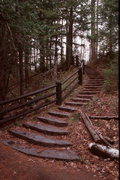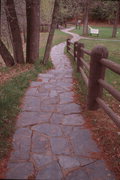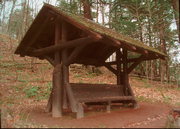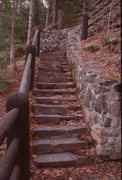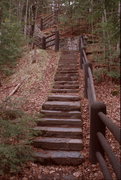Property Record
COPPER FALLS STATE PARK
Architecture and History Inventory
| Historic Name: | Copper Falls State Park |
|---|---|
| Other Name: | Copper Falls State Park Landscape Features (DNR) |
| Contributing: | Yes |
| Reference Number: | 16990 |
| Location (Address): | COPPER FALLS STATE PARK |
|---|---|
| County: | Ashland |
| City: | |
| Township/Village: | Morse |
| Unincorporated Community: | |
| Town: | 45 |
| Range: | 2 |
| Direction: | W |
| Section: | 17 |
| Quarter Section: | SE |
| Quarter/Quarter Section: | SW |
| Year Built: | 1937 |
|---|---|
| Additions: | |
| Survey Date: | 1991 |
| Historic Use: | trail/walk/stairs |
| Architectural Style: | NA (unknown or not a building) |
| Structural System: | |
| Wall Material: | Cut Stone |
| Architect: | Ccc/wpa; William E. Reimschneider (covered benches) |
| Other Buildings On Site: | |
| Demolished?: | No |
| Demolished Date: |
| National/State Register Listing Name: | Copper Falls State Park |
|---|---|
| National Register Listing Date: | 12/16/2005 |
| State Register Listing Date: | 9/23/2005 |
| National Register Multiple Property Name: |
| Additional Information: | A 'site file' exists for this property. It contains additional information such as correspondence, newspaper clippings, or historical information. It is a public record and may be viewed in person at the State Historical Society, Division of Historic Preservation. Landscape features found in the park include cut stone walls, stone and log fences, staircases, viewing vistas, retaining walls, cut stone pathways, and two covered log shelters. The majority of these features were constructed in 1937, though one cut stone wall and fence was constructed in 1927 and two walkways and two stairways were constructed in 1940. There are nineteen associated structures. Copper Falls State Park is renowned for its spectacular scenery and its lush forests. Visitors experience its seemingly primeval appearance: dramatic waterfalls framed by majestic pines and an understory of fern-like white cedars. But this landscape bears a remarkable human imprint. In the late nineteenth century, Wells Ruggles began reshaping the landscape when he attempted to mine the land for copper, sinking a nearly horizontal shaft into a hillside at the southeast corner of the present picnic grounds. The swift-flowing Bad River continually flooded this shaft, so in 1902 Ruggles and his crew diverted the stream by blasting through rock. Ruggles shifted the stream’s course north of the present picnic area; the old riverbed remnant is visible east of the combination picnic and concession building. In 1929, decades after Ruggles' mine failed, the state of Wisconsin created Copper Falls State Park with the assistance of the Depression-era Civilian Conservation Corps (CCC) and other federal agencies (see FR2). CCC workers found a nearly denuded landscape, which had been logged out during the lumber boom. They set to work planting thousands of trees, creating the forest visitors see today. This landscape design included plants, trails, stone stairways, and various structures designed in a rustic manner to make them seem part of the natural environment. The Wisconsin Conservation Department and the National Park Service developed the plans, and CCC workers provided the labor. In constructing most of the extant buildings, the CCC men shaped the logs to fit snugly without gaps, a method used by Nordic immigrants to Wisconsin. (Some chinking became necessary after the green wood shrank.) They joined the peeled logs with saddle notches and finished the ends with v-shaped tapers. Examples of the CCC work are visible throughout the park, although many original structures are gone. Bernard Knobla of the National Park Service designed the Combination Building. The Custodian’s Residence and the adjacent stone storage building were also built by the CCC and the Works Progress Administration, another New Deal jobs program. On the footbridge just above the Cascades on the Tyler Forks River, the deck and foundation are intact, but the new railing has three rows of boards instead of the original two. Notice the steps made of black slate slabs, which the CCC quarried in nearby Mellen. The long steps flanking the modern footbridge above Devil’s Gate are particularly impressive. A climb up the Observation Tower provides a panoramic view; the tower itself is a recent reconstruction, but the giant supporting timbers are original. |
|---|---|
| Bibliographic References: | Buildings of Wisconsin manuscript. |
| Wisconsin Architecture and History Inventory, State Historic Preservation Office, Wisconsin Historical Society, Madison, Wisconsin |

